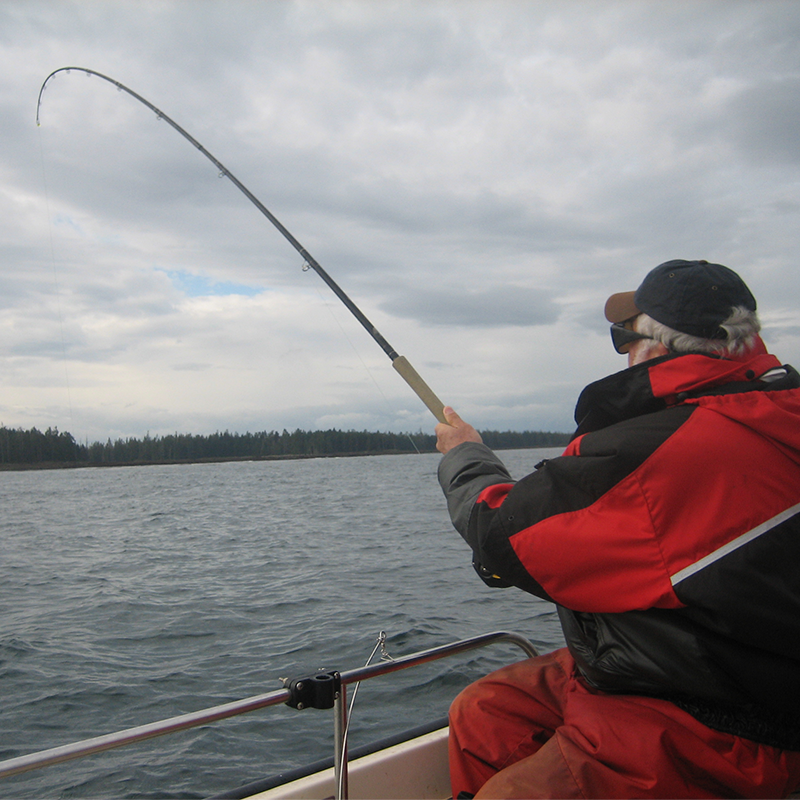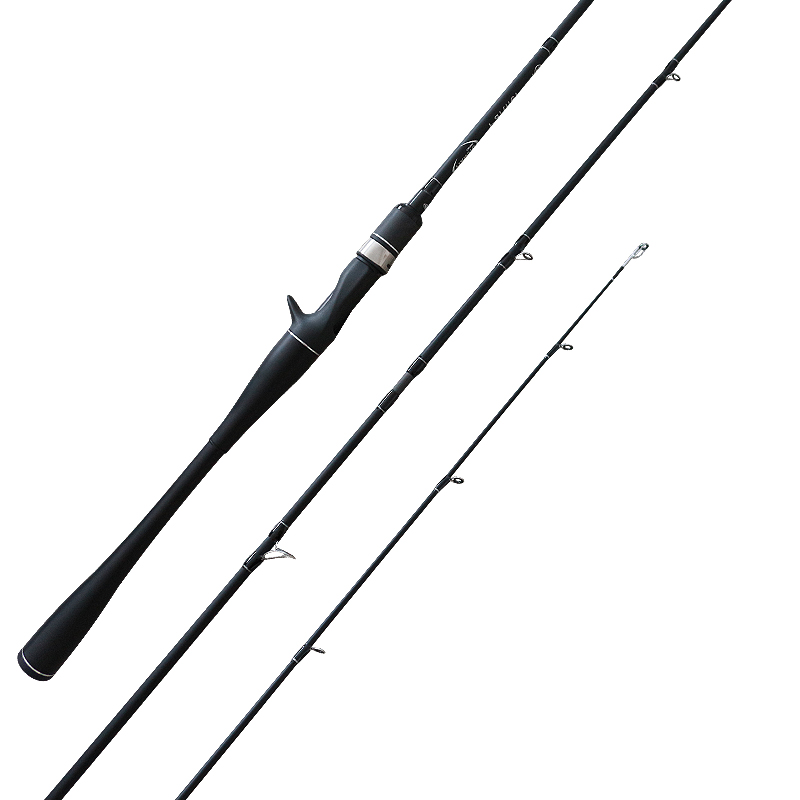
Picking the right fishing rod can be overwhelming. With so many options, how do you choose the perfect one?
Choosing the right rod is crucial for successful fishing. Length, material, action, and power all play important roles in performance.
In this post, we’ll break down how to select the right fishing rod based on your fishing style and needs.
Understanding the Basics of Fishing Rods
What Is a Fishing Rod?
A fishing rod is a tool used to catch fish. It works by casting a line and bait into the water, allowing anglers to reel in fish.
The fishing rod is made of different parts that contribute to its overall performance:
Rod Blank: The main part of the rod, providing flexibility and strength.
Guides: Rings that the fishing line passes through, reducing friction for smoother casts.
Handle: The part you hold, offering grip and comfort.
Reel Seat: Holds the reel securely in place.
Each of these parts is essential. For example, the material of the rod blank affects its sensitivity, while the guides help reduce line friction, making casting easier.
Why Is Choosing the Right Fishing Rod Important?
Selecting the right rod can make or break your fishing experience. A well-suited rod improves your casting accuracy, making it easier to land fish at a distance.
The right fishing rod also improves fish detection. A sensitive rod lets you feel even the lightest bite, while a stronger rod helps in pulling larger fish from tough spots.
Comfort matters too. A well-chosen rod feels balanced and easy to handle, allowing for longer fishing sessions without discomfort.
Different rods cater to different needs. For instance, a shorter rod provides better control in tight spaces, while a longer rod offers extended casting distance.
Key Factors in Picking the Right Fishing Rod
What Type of Fishing Will You Be Doing?
Freshwater vs. Saltwater Fishing
Fishing in freshwater and saltwater requires different rod features. Freshwater rods are typically lighter, as they target smaller fish. Saltwater rods, on the other hand, need to withstand harsh conditions. They’re made of corrosion-resistant materials to deal with saltwater’s effects on equipment.
Saltwater rods also tend to be heavier, designed for big fish like tuna or marlin. For long-lasting performance, you’ll need rods made of materials that resist rust and wear.
Special Fishing Techniques
Different fishing techniques need specialized rods. For example, fly fishing uses long rods for casting lightweight flies across long distances. These rods are flexible and designed for delicate casting.
Trolling, jigging, and bottom fishing often require shorter rods. Shorter rods give better control and help anglers manage heavier lures or larger fish in specific environments.
What Are the Different Types of Fishing Rods?
Spinning Rods
Spinning rods are the most versatile option. They’re perfect for all types of fishing, especially for beginners. Their design makes casting easier and more accurate, especially when using lightweight lures.
Spinning rods work well with a variety of baits and tackle. They are easy to use, making them ideal for casual anglers.
Baitcasting Rods
Baitcasting rods are built for more experienced anglers. They offer greater precision and power, allowing you to control heavier lures and lines with better accuracy. They are ideal for larger fish and fishing in tougher conditions.
These rods are best for anglers who need more control when casting and hooking big fish.
Fly Rods
Fly rods are specialized tools for fly fishing. They are long and flexible, designed to present flies gently and accurately. The slower action and extra length help cast the fly over long distances with finesse.
If you’re fishing in rivers or streams for trout or salmon, a fly rod is your go-to choice.
Ice Fishing Rods
Ice fishing rods are short and compact, designed for fishing in cold weather and tight spaces. These rods are typically used for vertical fishing, where you drop your line straight down into the water through an ice hole.
Ice fishing rods need to handle extreme cold, so they are made from durable, high-quality materials that won’t break under freezing conditions.

Key Fishing Rod Features to Consider
What Is the Right Fishing Rod Length?
How Does Rod Length Affect Casting?
The length of your fishing rod impacts your casting distance and control. Longer rods generally allow for greater casting distances. However, they can be harder to maneuver. On the other hand, shorter rods are ideal for precision casting and better control, especially in tight spots or dense cover.
When choosing rod length, consider your fishing environment. If you're fishing in open water, a longer rod will give you a broader reach. In more confined spaces, such as fishing from a kayak or around obstacles, shorter rods offer better maneuverability.
When to Choose a Longer or Shorter Rod
A longer rod gives you leverage when fishing in open water, helping to pull in large fish. But in areas like dense brush or small boats, a shorter rod is more manageable. The right length depends on where and how you're fishing.
What Rod Material Should You Choose?
Fiberglass Rods
Fiberglass rods are durable and flexible, making them suitable for a variety of fishing techniques. They are heavier and less sensitive than graphite rods, but they are less likely to break under stress. These rods are often a great choice for fishing in tough conditions or for anglers looking for an affordable, reliable option.
Graphite Rods
Graphite rods are lightweight and offer excellent sensitivity, allowing you to feel subtle bites. They are ideal for longer casts and precise fishing, especially in situations where sensitivity is key. Experienced anglers often prefer graphite rods for their responsive feel and performance.
Composite Rods
Composite rods combine fiberglass and graphite to provide a balanced mix of durability and sensitivity. These rods are versatile, making them an excellent choice for anglers who fish in diverse conditions. They offer better performance than fiberglass alone and are more affordable than pure graphite rods.
What Is the Right Action for a Fishing Rod?
Fast Action Rods
Fast action rods bend mostly at the tip. They’re ideal for powerful hook sets, making them a great choice for catching larger fish. Fast rods respond quickly, helping you set the hook with precision and pull fish from heavy cover.
Medium Action Rods
Medium action rods offer a blend of flexibility and strength. They are versatile enough to handle various fishing styles, from casting to trolling. These rods also offer longer casting distances, making them suitable for anglers targeting a range of fish species.
Slow Action Rods
Slow action rods bend more throughout the rod. These rods are perfect for smaller fish and delicate lures. Their softer bend makes them ideal for finesse fishing, where small baits need to be cast precisely.
What Is Rod Power and Why Does It Matter?
Understanding Rod Power Ratings
Rod power refers to the rod’s resistance to bending and lifting strength. The power rating determines the appropriate line weight and the size of fish the rod can handle. Rods are typically categorized as ultra-light, light, medium, medium-heavy, heavy, and ultra-heavy.
The power rating of the rod impacts how much weight it can handle without breaking. It also plays a role in the casting distance and the ability to fight larger fish.
Matching Rod Power to Fishing Style
Heavier rods are ideal for larger fish species, such as tuna or marlin, and for tough fishing conditions like offshore fishing. Lighter rods are more suitable for finesse techniques or fishing smaller fish like trout or panfish. The power rating you choose should match both the fish you're targeting and the fishing environment.
Matching Your Fishing Rod to Your Target Fish
How to Choose the Right Fishing Rod for Freshwater Fishing?
When fishing for bass, trout, or other freshwater species, rod selection matters. Generally, freshwater rods are lighter and more sensitive, giving you better control.
Rod Length: A 6-7 foot rod works well for most freshwater fishing. Shorter rods provide more control, while longer rods offer better casting distance.
Rod Action: For bass, a medium or fast action rod is ideal for quick hook sets. For trout, you may want a slower action rod for lighter bites.
Rod Power: A medium power rod is good for general freshwater fishing. For larger bass or pike, a medium-heavy rod offers more strength.
How to Choose the Right Fishing Rod for Saltwater Fishing?
Saltwater fishing presents unique challenges, mainly because of the harsh environment.
Rod Durability in Saltwater
Saltwater rods need to be more durable and resistant to corrosion. The exposure to saltwater can wear down materials over time, so choosing rods made with corrosion-resistant materials is crucial. Graphite and fiberglass composites work well here. These materials can handle the extra strain of larger fish in saltwater.
Choosing a Rod for Larger Saltwater Fish
For big game fishing (e.g., tuna, tarpon), a heavier rod is a must. These rods need enough power to handle the fight.
Rod Power: Choose a heavy or extra-heavy rod to deal with large fish.
Action: A fast action rod provides more sensitivity and quick hook sets, crucial for large, fast-moving fish.
Material: Opt for a composite rod with high resistance to corrosion and high power.
How to Select the Best Fishing Rod for Big Game Fishing?
Big game fishing requires rods designed to withstand the force of large fish. These rods are stronger, with more power to handle the fight.
Power: Rods rated for heavy or extra-heavy power are essential.
Action: Fast action rods are needed for quick, sharp hook sets and to manage the heavy load of large fish.
Rod Material: Composite rods with a blend of graphite and fiberglass provide strength and flexibility, perfect for fighting big fish like marlin and tuna.
Conclusion
When choosing a fishing rod, consider your fishing style, rod length, power, material, and action. Our Fishing Rods at Weihai Huayue Sports are designed for both amateur and professional anglers, offering exceptional performance and durability. Made with high-quality Carbon Fiber, they are perfect for freshwater and saltwater use.
Invest in a rod that enhances comfort and precision for a successful fishing experience. Explore our Fishing Rod Combo options today. For assistance, feel free to contact Weihai Huayue Sports, your trusted partner in fishing tackle.
FAQs
Q: Can You Use a Spinning Reel on a Baitcasting Rod?
A: No, spinning reels are designed for spinning rods, while baitcasting reels work with baitcasting rods. Each reel type requires specific rod designs for optimal performance.
Q: Can You Use a Freshwater Rod for Saltwater Fishing?
A: It’s not recommended. Freshwater rods are not designed to withstand the corrosive effects of saltwater, which can damage the rod and reel. Saltwater rods are built with corrosion-resistant materials for durability.
Q: What Is the Best Fishing Rod Length for Surf Fishing?
A: Surf fishing requires longer rods, typically between 10-14 feet, to cast beyond the breaking waves and handle larger fish species found in deep water.



